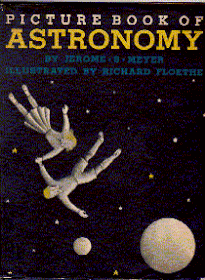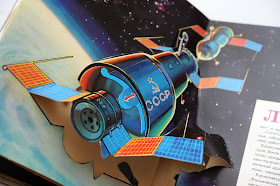Wednesday, June 29, 2011
Picture Book of Astronomy (1945)
The Picture Book of Astronomy lurks on that line between space travel being fiction and space travel being a real possibility. This wonderful children's book has a style that suggests more than basic astronomic facts are being presented. It is only a 36 page book and obviously intended for parents to purchase for their children. As World War 2 finished there was a perceived need to have more new books specifically aimed at children.
Meyer, Jerome S. Illustrated by Floethe, Richard. Picture Book of Astronomy. New York: Lothrop, Lee and Shepard. (36 p.) 29 cm. 1945
I like the imagery in the book of children going out into space. Under the dust jacket of the book is this imaginary space ship illustration embossed on the actual cover:
The text discusses gravity, the Earth's rotation, and conditions on the Moon and the planets. Wonderful illustrations include those of a rocket launch, children floating inside the spacecraft looking at the Earth, children exploring the Moon, and children visiting Mars (with vegetation). One of the earliest non-fiction children's books I have found showing a rocket flight to the Moon. Also reprinted in the late 1950s (undated).
I have found very few children's books before this time that showed children floating weightlessly or view the Earth from space.
My favorite illustration is the actual landing on the Moon. While this seems familiar to science fiction readers it is being presented to children as a imaginative possibility.
I do agree that the space helmet and hiking shorts wardrobe is a little unusual but it also seems to communication that this is not a dream or fantasy but rather real children hiking and looking up at the earth in sky.
A dream of rockets flying above our cities on their way to the Moon.
Wednesday, June 22, 2011
Grishka and the Astronaut (1970/1981)
Grishka and the Astronaut was a 1970 fictional Russian story about how when a boy speaks to an astronaut for advice he is told to visit the Moon. The translation was done in 1981 as part of that flourish of children's books from Russia in the early 1980s that I have mentioned.
A. Mityayev ; drawings by Yuri Molokanov ; translated from the Russian by Ronald Vroon. Translation of: Kosmonavt i Grishka.(1970). Moscow : Progress ; [London] : distributed by Central, 1981 [20 p.] : 28 cm.
The illustrations by Yuri Molokanov are especially charming. I picked out some of my favorite rocket related ones to share with you today.
Talking with the astronaut (shouldn't that be cosmonaut?) at his house. I especially like the decorations and models the astronaut has at his house.
A very nice and understated picture of a rocket launch. The text describes how as the rocket launched leaves fell from the trees and the birds scattered.
Flying through space to the Moon.
The joys of leaping on the Moon.
Even better than leaping on the Moon is the ability to lift huge boulders because of the lowered gravity. I wonder if the Apollo astronauts ever tried anything similar or was it too dangerous/silly?
Landing on an asteroid and having to be rescued by a friend he found.
And maybe my favorite illustration: playing volleyball with boulders on the Moon. Outside of the dangers of breaking your helmet this seem almost cooler than baseball on the Moon. Dreams of space included playing games with your friends in new places.
Friday, June 17, 2011
Journey Into Space (1959)
Journey Into Space was a classroom pamphlet. In the boom of books about space came a lack of classroom materials to teach children. Pamphlets filled in this hole by giving an inexpensive way to purchase multiple copies of "interesting" reading.
Vessel, Mathew F. and Wong, Herbert H. Journey Into Space San Francisco: Fearon Publishers. (14 p.) 22 cm. 1959. Part of the "Fearon Science education" series
While not very inspiring text it captures that moment when even the teachers were convinced that they were teaching knowledge that would be desperately needed by the late 1960s.
This chart at the back shows how it was expected that the book would be out of date by the time it was printed so the reader would needed to add the latest achievements.
Also this pamphlet has a logo that is near and dear to my heart. In fact I almost used it as the image for this blog.
The answer to that question of course is use them all!
Thursday, June 9, 2011
Whopper Space Stories (1955)
This was a Children's Annual with stories, games, and cartoon strips. It had a couple of striking illustrations.
Boyd, Edward and Allward, Maurice. Illustrated by North, T E, Branton, R.A. and Gaffron, Bruce. Whopper Space Stories. London : Children's Press. (62 p.) 26 cm. Softcover. 1955
IA softcover reduced version of “The Giant Book of Amazing Stories" 1952. Still includes the articles by Maurice Allward with a comic strip and several fictional space stories. Has the same cover and illustrations (for the included articles) but no color plates.
The cover show the varieties of thought about what a space station would eventually look like. I would love to watch that "von Braun/Bonestell" ship dock from the railing of my space hotel. It was painted by T.E. North (Thomas Edward). He did a number of children's books and covers as described here: http://bearalley.blogspot.com/2009/08/t-e-north.html
Boyd, Edward and Allward, Maurice. Illustrated by North, T E, Branton, R.A. and Gaffron, Bruce. Whopper Space Stories. London : Children's Press. (62 p.) 26 cm. Softcover. 1955
IA softcover reduced version of “The Giant Book of Amazing Stories" 1952. Still includes the articles by Maurice Allward with a comic strip and several fictional space stories. Has the same cover and illustrations (for the included articles) but no color plates.
The cover show the varieties of thought about what a space station would eventually look like. I would love to watch that "von Braun/Bonestell" ship dock from the railing of my space hotel. It was painted by T.E. North (Thomas Edward). He did a number of children's books and covers as described here: http://bearalley.blogspot.com/2009/08/t-e-north.html
While very primitive in some ways I like the feeling of "brave explorer" that this illustration gives.
See the 1952 book at: http://dreamsofspace.blogspot.com/2009/06/giant-book-of-amazing-stories-1955.html
I also like this very classic rocket illustration with the windows on the front of the rocket. You can see how rocket design really missed the boat when they stopped emulating the latest streamlined cars. Now that the old fleet is being retired "Shuttle Prius" anyone?
Friday, June 3, 2011
B KOCMOC/ Into Space (1978)
A little out of my defined 1945-1975 time period but too good not to share. This pop-up book was part of the burst in Russian children's publishing in 1978. Or at least that what it seems like to me. I find a number of 1978-1983 Russian titles for children and a number were translated into English.
Since it is very hard to use a scanner to show pop-up books (my preferred tool) I had to wait until I could get someone to take photographs of this book. Even the back of the book is beautiful:
There are a couple of American pop-up books about space, the most famous being about the Apollo 11 landing. I will have to try and take some photographs for you.
The feeling I get when looking at Russian books is like that of looking into a distorted mirror. The overall images are familiar but the details are just a little different.
The walk in space and seeing the Earth from orbit....
Docking in space....
Exploring the Moon....
Our brave new future in space.....
Since it is very hard to use a scanner to show pop-up books (my preferred tool) I had to wait until I could get someone to take photographs of this book. Even the back of the book is beautiful:
There are a couple of American pop-up books about space, the most famous being about the Apollo 11 landing. I will have to try and take some photographs for you.
The feeling I get when looking at Russian books is like that of looking into a distorted mirror. The overall images are familiar but the details are just a little different.
The walk in space and seeing the Earth from orbit....
The return to Earth (on land!).....................
Docking in space....
Exploring the Moon....
Our brave new future in space.....



















